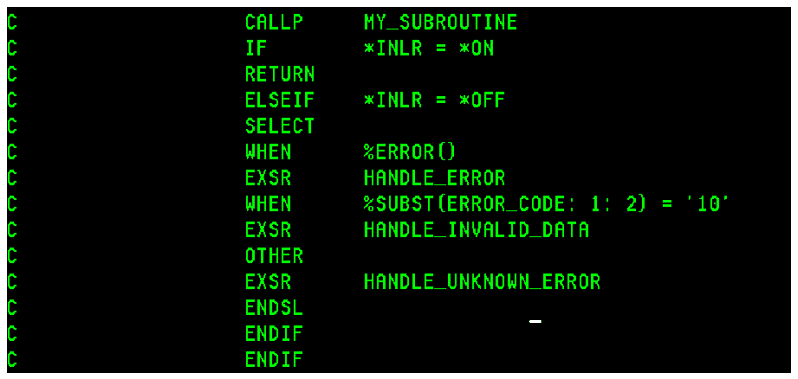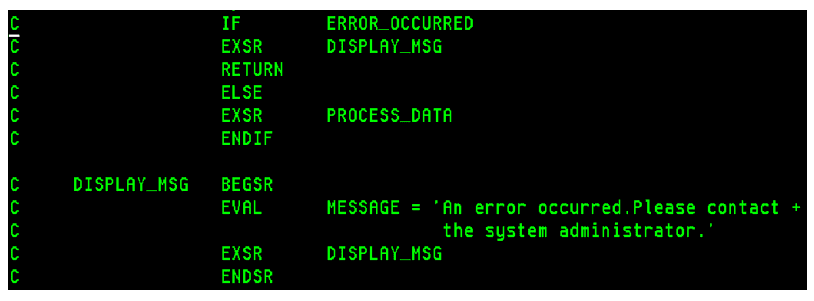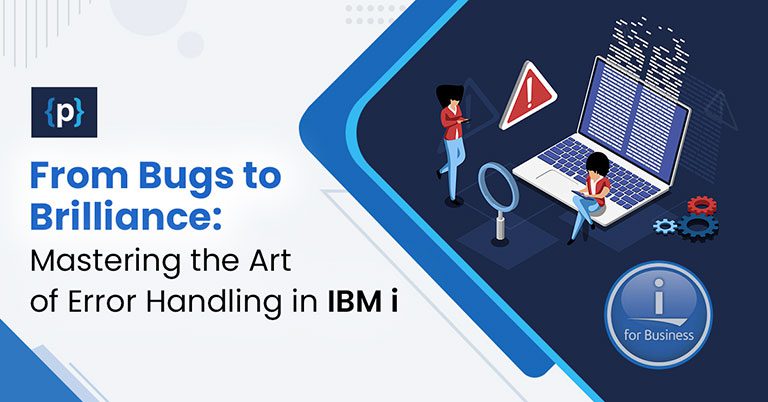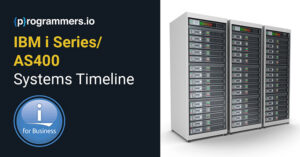From Bugs to Brilliance: Error Handling in IBM i/AS400
“Are you looking for exceptional error handling in AS/400?”
Then, your search ends here as I unveil a remedy that you have been looking for.
What is error handling in IBM i/AS400?
Error handling is how developers or software handle potential failures. For example, failing to read a file properly and using the bad input generated would be problematic. Power Systems, also known as IBM iSeries or IBM Power Systems, is a robust system widely used in businesses because of its exceptional capabilities. Effective AS/400 error handling ensures stability, reliability, and optimal performance of applications running on the IBMi platform.
Best Practices for Error Handling in IBM i/AS400
1. Structured Exception Handling (MONITOR and ON-ERROR):
The RPGLE provides MONITOR and ON-ERROR operations that enable structured exception handling. This block lets you wrap code where errors are possible. Control is transferred to the ON-ERROR block when an error occurs within the monitored block. Utilizing MONITOR and ON-ERROR allows errors to be caught and fixed without interrupting the program flow.

The example above shows that the MONITOR block encapsulates the code section that may throw an error. Control is transferred to the ON-ERROR block if the PROCESS_DATA subroutine (EXSR) encounters an error. In the ON-ERROR block, the HANDLE_ERROR subroutine (EXSR) can perform error-specific actions, such as notifying the user or logging error details.
2. Error Code Checking
To detect and handle errors, error code checking is a common practice in RPG. A specific error-handling logic can be implemented based on the error codes returned by various operations and APIs. Error Code Data Structures (ECDSs) standardize how error codes are recognized and analyzed. It contains fields such as the Program Status code (PS), the error Exception ID (EXCPID), and the Exception Message (EXCPMSG).

In the above example, after calling the MY_SUBROUTINE program, we check the *INLR (Indicator for Last Record) indicator. If *INLR = *OFF, we use the %ERROR () function to determine if an error has occurred. We can call different subroutines to handle specific error scenarios based on the error code or other relevant conditions.
3. RPG Exception/Error Messages
End users must receive clear and meaningful error messages to handle errors effectively. Data Definition Specifications (DDS) in RPGLE allow you to define your error messages using the Message Description (MSGD) keyword. It is possible to enhance the user experience by assigning specific error codes to custom error messages to help programmers understand the error better.

In the above example, when an error occurs (ERROR_OCCURRED), MONITOR and ON ERROR operations call the DISPLAY_ERROR_MESSAGE subroutine, which displays a customized error message. Using the DISPLAY_MESSAGE subroutine, the message can be displayed on the screen or logged for further analysis.
Benefits of Effective Error Handling
-
System Stability
By managing errors quickly and efficiently, we can prevent system crashes and minimize the impact on overall system stability. Proper error management also helps isolate mistakes and maintain a smooth system operation.
-
Data Integrity
Errors can lead to data corruption or loss, which is always possible. The AS/400 system uses error-handling mechanisms that ensure data integrity and accuracy by identifying and resolving data-related issues.
-
User Experience
A well-designed error-handling system communicates meaningful error messages and instructions to users, guiding them through unexpected situations. This enhances the user experience and reduces frustration by helping users solve issues more quickly.
Conclusion
Error handling plays a vital role in maintaining the stability, integrity, and usability of AS/400 applications. It is possible to minimize the impact of errors, improve the resilience of your system, and provide a better user experience by implementing effective error-handling practices. By emphasizing comprehensive logging, structured exception handling, error code standardization, user-friendly messages, error reporting and monitoring, rigorous testing, and disaster recovery planning, IBM i/As400 developers proactively identify and handle errors, which can lead to a more stable program overall. Organizations can deliver seamless user experiences by prioritizing error handling in AS/400 applications.
How can we help you?
We have hundreds of highly-qualified, experienced experts working in 70+ technologies.









